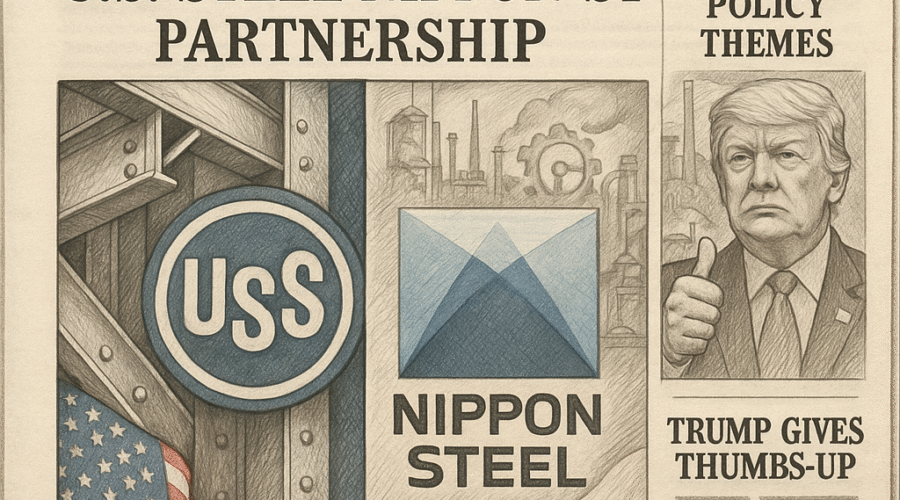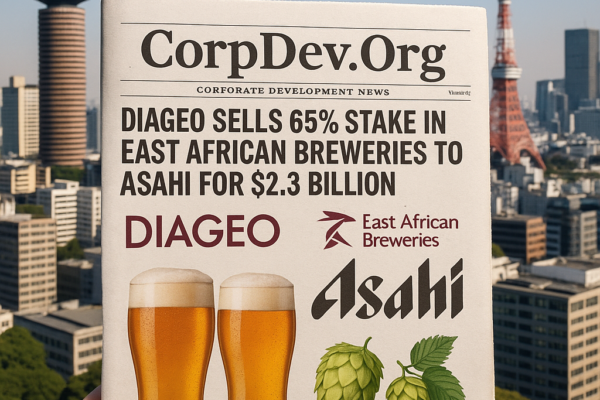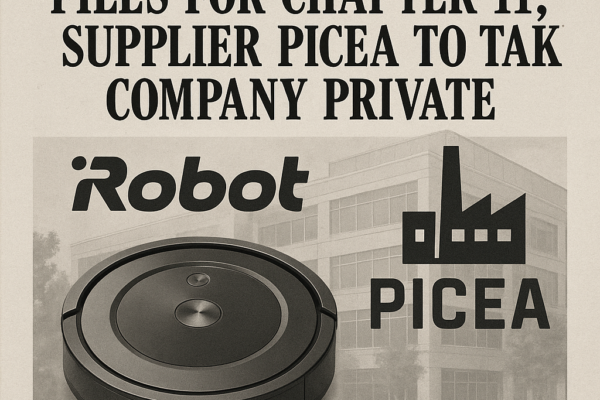The proposed $14 billion strategic partnership between U.S. Steel and Nippon Steel represents a paradigm shift in American industrial policy, blending protectionist trade measures with selective foreign investment to revitalize domestic manufacturing. Announced by President Donald Trump on May 23, 2025, this arrangement replaces Nippon’s blocked $14.9 billion acquisition attempt with a capital infusion model preserving U.S. Steel’s corporate sovereignty while leveraging Japanese technological expertise[1][2][9]. The deal commits to creating 70,000 jobs, modernizing aging facilities across Pennsylvania, Indiana, and Arkansas, and maintaining Pittsburgh as the operational headquarters – concessions designed to appease political and labor stakeholders[2][12][17]. Market response was immediate, with U.S. Steel shares surging 21% as investors priced in reduced regulatory risk and anticipated productivity gains from Nippon’s advanced steelmaking techniques[10][13].
💼 Seasoned CorpDev / M&A / PE expertise
Strategic Rationale and Structural Components
From Acquisition to Capital Partnership
The revised agreement transforms Nippon Steel’s role from acquirer to strategic financier, injecting $14 billion over 14 months through a combination of equity purchases and facility upgrade commitments[2][9][12]. This structural pivot addresses CFIUS’ national security concerns about foreign control while channeling Japanese capital into critical infrastructure modernization – particularly in electric arc furnace technology and low-emission production methods[3][5][7]. The partnership framework allows U.S. Steel to retain its NYSE listing and corporate identity, mitigating political backlash against foreign ownership of an American industrial icon[6][14][16].
Technological Transfer Mechanisms
Nippon’s investment package includes proprietary access to its NEXTIA steelmaking system, which reduces carbon intensity by 30% compared to traditional blast furnace methods[3][5]. Implementation will occur through joint ventures at three flagship facilities: Mon Valley Works (Pennsylvania), Gary Works (Indiana), and Big River Steel (Arkansas). These sites will serve as testbeds for hydrogen-based reduction processes and AI-driven quality control systems adapted from Nippon’s Nagoya Works[5][7][9].
Political Engineering of the Deal
Regulatory Chess Match
The partnership concludes a 17-month regulatory saga that saw the Committee on Foreign Investment in the United States (CFIUS) reverse its position under changing presidential administrations. President Biden’s January 2025 blocking order cited vulnerabilities in defense supply chains and potential technology leakage[6][9][14], while Trump’s May approval reframed the arrangement as reinforcing American industrial capacity against Chinese competition[4][12][17]. Legal scholars note the deal establishes precedent for bifurcated foreign investment models where capital and technology transfer occur without equity control[9][14].
Tariff Policy Synergies
Trump’s restored Section 232 tariffs created essential leverage for negotiations, with the 25% steel import duty making domestic modernization financially preferable to offshore production[4][9][12]. The White House estimates the tariffs generated $8.2 billion in annual revenue since their February 2025 reinstatement, funds being partially redirected to offset worker retraining costs under the partnership[4][17]. This fiscal engineering enables political claim to both protectionist credentials and job creation metrics.
Labor Dynamics and Union Calculus
United Steelworkers’ Conditional Support
While opposing Nippon’s initial acquisition bid over job security concerns, the USW has cautiously endorsed the partnership framework following strengthened commitments to no layoffs until 2035 and $4.1 billion in pension fund contributions[2][8][9]. The deal incorporates binding arbitration mechanisms through the Department of Labor to resolve disputes over technology implementation impacts – a concession extracted during Trump’s April 2025 negotiations with union leadership[8][9][17].
Workforce Transition Challenges
Modernization plans will require retraining 34% of U.S. Steel’s 22,000-strong workforce in digital systems management and advanced metallurgy. Nippon has committed $850 million to a joint skills academy with Pennsylvania State University, targeting certification of 15,000 workers in automation maintenance and process engineering by 2027[3][7][9]. Early retirement packages for 2,500 legacy blast furnace operators remain contentious, with local unions negotiating enhanced severance terms[8][15].
Market Implications and Competitive Landscape
Capacity Expansion Timelines
The partnership targets 18% increase in U.S. Steel’s annual production capacity to 28.4 million tons by 2028, focusing on high-margin automotive and electrical steel segments[3][7][14]. Nippon’s proprietary ZAM® corrosion-resistant steel formulations will be manufactured domestically, potentially capturing 12% of the North American automotive sheet market from Cleveland-Cliffs and ArcelorMittal[5][10][14].
Financial Engineering Considerations
U.S. Steel’s restructured balance sheet will carry $6.2 billion in preferred shares held by Nippon, convertible to 15% common equity post-2030 contingent on employment and production targets[9][10][12]. This hybrid instrument structure allows near-term liquidity relief while deferring foreign ownership debates – a model already attracting interest from European automakers seeking similar partnerships[10][14].
Geopolitical Repercussions
US-Japan Industrial Alignment
The deal formalizes technology sharing agreements under the 2024 Critical and Emerging Technologies (CET) Initiative, with Nippon gaining access to U.S. Steel’s military-grade armor plating patents in exchange for semiconductor-grade steel production techniques[5][7][14]. This cross-licensing arrangement strengthens bilateral cooperation against Chinese steel dumping, which currently constitutes 37% of global overcapacity according to OECD estimates[4][12][17].
NATO Supply Chain Implications
Modernized U.S. Steel facilities will become primary suppliers for AUKUS submarine components and NATO artillery shell production, reducing European dependence on Russian-sourced specialty steels[4][9][14]. The Pentagon has pre-approved seven partnership sites for Defense Production Act funding allocations, ensuring military procurement priorities align with capacity expansion plans[9][17].
Conclusion: A New Template for Strategic Industries
This partnership establishes a viable model for balancing foreign investment with national industrial priorities – leveraging capital and technology inflows while retaining domestic control over critical infrastructure. Success metrics will hinge on effective execution of workforce transitions and demonstrated competitiveness against Chinese state-subsidized producers. The arrangement’s hybrid structure likely informs upcoming CFIUS reviews in semiconductor and rare earth sectors, suggesting broader application of regulated partnership frameworks in sensitive industries.
Sources
https://www.cbsnews.com/news/trump-us-steel-nippon-steel/, https://www.foxbusiness.com/politics/trump-touts-partnership-steel-deal-nippon-us-steel-will-remain-america, https://www.nipponsteel.com/en/news/20240315_100.html, https://www.whitehouse.gov/fact-sheets/2025/02/fact-sheet-president-donald-j-trump-restores-section-232-tariffs/, https://en.wikipedia.org/wiki/Nippon_Steel, https://en.wikipedia.org/wiki/U.S._Steel, https://www.nipponsteel.com/en/news/20240530_100.html, https://usw.org/bargaining-update/nippon-is-not-the-future-of-u-s-steel/, https://www.politico.com/news/2025/05/23/trump-approves-nippon-purchase-us-steel-00368171, https://www.investopedia.com/us-steel-stock-soars-as-trump-oks-nippon-steel-partnership-11741309, https://www.axios.com/2025/05/23/us-steel-nippon-steel-trump, https://english.news.cn/northamerica/20250524/12ef0eccdbc346a8917f97b1c4f9304f/c.html, https://www.youtube.com/watch?v=CzmiJ-Ap24k, https://en.wikipedia.org/wiki/Proposed_acquisition_of_U.S._Steel_by_Nippon_Steel, https://www.publicsource.org/trump-us-steel-hq-partnership-japan-nippon/, https://abcnews.go.com/Business/wireStory/trump-us-steel-hq-pittsburgh-part-14b-partnership-122129078, https://mynbc15.com/news/nation-world/trump-approves-us-steel-nippon-partnership-announces-big-rally-in-pittsburgh-pennsylvania-japanese-company-biden-blocked-national-security-tariffs-america-jobs-investment





